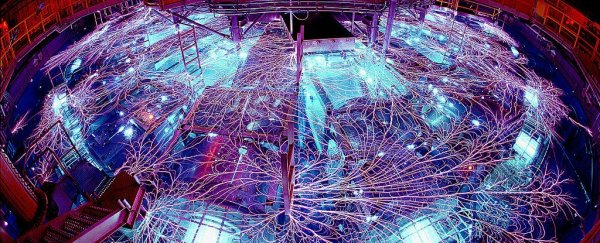The Universe is full of phenomena that we can't fully explain: black holes, exploding stars, rapidly spinning stellar corpses…
In order to get closer to understanding these cosmic oddities, scientists have to constantly push the boundaries of science, advancing technology and marrying seemingly unrelated fields of physics to create more powerful theories.
Researchers at the Princeton Plasma Physics Laboratory (PPPL) have developed a new way to explore some of the most extreme environments in the Universe by combining three separate branches of physics: high energy physics (which describes charged particles travelling at or close to the speed of light), quantum mechanics (which describes the motion of subatomic particles), and Einstein's theory of special relativity (which describes the propagation of matter and light at high speeds).
"People haven't done this before," Yuan Shi, a graduate student in the PPPL and lead author of a paper published July 29 in the journal Physical Review A, told Business Insider. "Nobody really wanted to cross the boundaries between the disciplines to see what other scientists are doing. The difficulty was mostly that there's no communication between these fields."
The new hypothesis allows scientists to better investigate mysterious stellar objects called pulsars, and might bring us closer to achieving fusion energy here on Earth.
Cosmic lighthouses
When a massive star collapses and dies in a supernova explosion, the stellar corpse left over can form something called a neutron star - an insanely dense object composed of tightly packed neutrons.
If one of these neutron stars becomes magnetised enough, it begins spinning at an extremely rapid pace, spitting out beams of light at regular intervals, like cosmic lighthouses.
Scientists want to know the strength of the magnetic field and the density of the plasma surrounding these pulsars.
The density of the plasma, which consists of extremely hot clouds of electrons and ions, can be millions of times greater than that of stars like the Sun. And the magnetic fields can be billions of times stronger than any magnet you can buy on Earth.
Scientists use telescopes to observe the strange behaviour of these stars. One way they do this is by analysing the spectrum light coming from them. The particles that are bouncing around in the magnetosphere (the magnetised atmosphere surrounding the pulsar) absorb light waves.
These absorptions create peaks in the spectrum that scientists haven't been able to explain. By combining equations from special relativity and high-energy physics, Shi was able to figure out the causes of these absorptions and infer the density and field strength of the magnetosphere.
The new hypothesis developed at PPPL allows scientists to figure out the properties of pulsars in finer detail than ever before. By understanding the interactions behind the propagation of the particles, scientists can figure out the composition of the plasma.
"By understanding these strange stars, we may open up new possibilities for human beings," Shi said. "One hundred years later somebody might be able to make something out of what we find."
One step closer to understanding nuclear fusion
The new research also brings scientists one step closer to understanding nuclear fusion, which is energy produced by fusing together light atoms. This is the process that powers the Sun and the stars.
Scientists have been trying to create fusion power for nearly a century. By recreating it on Earth, scientists would essentially be creating artificial stars, and it would provide us with an unlimited source of clean, renewable energy.
During fusion experiments, scientists compress things to extreme densities to make conditions similar to what you'd find in a neutron star. This creates intense magnetic fields, millions of times stronger than an ordinary magnet.
As scientists get closer to recreating the conditions of what they find in the Universe, they find curious phenomena that they can't yet explain. According to Shi, it takes a combination of the three branches of physics to understand them.
The new technique can be used to figure out the density of the plasma and strength of the magnetic field created by something called inertial confinement fusion experiments, which use lasers to vaporise a target containing plasma fuel. This process causes an implosion that packs the fuel into plasma and produces fusion reactions.
"Researchers want to know the precise density, temperature and field strength of the plasma that this process creates," a PPPL press release writes.
Using the disciplines individually gives inconsistent answers. That's because while the plasma produces quantum effects, the magnetic field produces relativistic effects. The strength of this new hypothesis is that it combines the three different worlds.
"The most exciting thing is to bridge the gaps between different branches of physics and see that when they join forces, they are able to become even more powerful tools to describe the physical world," Shi said. "It can explain something under very extreme conditions that any individual theory is incapable of describing."
This article was originally published by Business Insider.
More from Business Insider:
